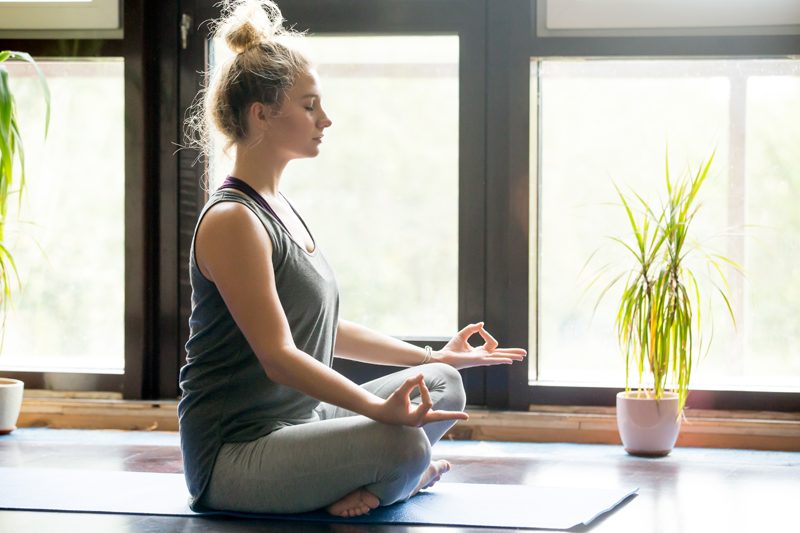
Book Focus: ‘Your Spine, Your Yoga’ by Bernie Clark
January 24, 2019
Free Your Fascia
February 7, 2019What is Jnana Yoga?

Instead of physical form, Jnana Yoga focuses on knowledge, wisdom, and intellect. Rather than concentrating on the exterior use of these aspects, the style uses self-realization. Because of this, Jnana is often considered to be the most challenging style of yoga. Using a huge amount of strength, patience, and will, the style uses self-questioning and reflection to help yogis connect with their inner-self. Rather than physical asanas, Jnana focuses on spiritual energy; however, the technique can be used alongside your regular yoga practice if you wish. Before beginning, it’s important to pick up some comfortable clothes. Choosing yoga sweatpants with a flexible waistband will keep you comfy throughout your practice. Below, we explore Jnana Yoga in more detail.
History Of Jnana
Dating back to the Vedic age, Jnana is one of the earliest forms of yoga. The technique was first written about in ancient Sanskrit texts, including the Bhagavad Gita and the Upanishads. In these scriptures, it is explained that Jnana should unite yogis with the ‘Ultimate Energy’. In the Bhagavad Gita, the style is described as a path to self-realization. According to the text, Jnana can be difficult because it deals with a formless reality; because of this, the technique requires a high level of intellect to be used correctly.
Jnana first became popular after the respected Advaita philosopher Adi Shankara preached about its importance. Over the years, the practice of Jnana has stayed more or less the same; however, there have been a few minor changes to the technique.
Practice
When using Jnana, practitioners must ask themselves a series of questions. Typically, these questions will help them to discover who and what they are. For best results, yogis should study Jnana alongside an experienced instructor or yoga ‘guru’. In one-to-one sessions, students can then meditate and reflect on their thoughts to unite their inner-being with the Divine. If you’re new to Jnana, your first few classes will focus on the Four Pillars of Knowledge and the Seven Stages of Wisdom. Below, we discuss these further.
The Four Pillars of Knowledge
The Four Pillars of Knowledge are designed to liberate you from your thoughts. When translated from Sanskrit, these steps are called ‘Sadhana Chatushtaya’. For best results, the pillars must be practiced in a certain order. This way, each step will set up your body and mind for the next.
Viveka
The first step is Viveka. To practice this pillar, you must use your conscious mind to distinguish the real from the unreal and the permanent from the temporary.
Vairagya
The second pillar is Vairagya. During this step, you must detach yourself from physical possessions. As possessions are thought to be temporary, detaching yourself from them will help you to achieve liberation. This pillar also teaches you to see things for what they truly are.
Shadsampati
The third pillar is Shadsampati. This step uses six different techniques to stabilize the mind and emotions. Each technique will teach you to see the world for what it really is. Below, we explore the six techniques.
- Shama: Shama is the first of the six techniques. Best described as the method of keeping calm, Shama teaches you to remain peaceful in times of stress.
- Dama: The second technique is Dama. This method teaches you to avoid the influence of external stimuli and focus on strengthening your mind.
- Uparati: The third technique, Uparati, teaches you to keep life simple. To limit unnecessary distractions, you are encouraged to avoid tasks that aren’t your responsibility.
- Titiksha: Titiksha is the fourth technique. This method teaches you to brave negative situations to become more tolerant of discomfort and suffering.
- Shraddha: The fifth technique is Shraddha. This method encourages you to respect your instructor and have faith in the Sanskrit texts.
- Samadhana: The final technique is Samadhana. This step teaches you to focus on your inner-self to achieve liberation.
Mumukshutva
Mumukshutva is the fourth and final Pillar of Knowledge. To achieve this step, you must commit yourself completely to self-realization. In order to do this, you must believe that nothing else truly matters.

The Seven Stages of Wisdom
Once you’ve mastered the Four Pillars of Knowledge, you can move onto the Seven Stages of Wisdom. During this process, you must overcome various challenges to become one with the higher self.
Subheccha
Subheccha is the first stage of wisdom. During this stage, you must become passionate about discovering the truth. To do this, you must study the Sanskrit texts under the guidance of your instructor.
Vicharana
The second stage of wisdom is Vicharana. Once you’ve learned the truth, you must spend time questioning it. During this process, you will discover what the knowledge really means.
Tanumanasi
Tanumanasi is the third stage of wisdom. By this point, you should have learned all the necessary knowledge. During this stage, you will learn to focus on your soul without letting external stimuli distract you.
Sattvapatti
The fourth stage of wisdom is Sattvapatti. During this stage, you must use deep focus to purify the mind. Suddenly, the path to realization will become clearer and desire will leave your mind. When you have achieved Sattvapatti, you’ll be able to see the truth clearly.
Asamsakti
Asamsakti is the fifth stage of wisdom. This stage teaches you to become detached and selfless. You will begin to look past the illusions of the world and your surroundings should no longer affect you.
Padartha Bhavana
The sixth stage of wisdom is Padartha Bhavana. During this stage, you will start to see things for what they really are. This stage also teaches you that your soul is the only thing that matters.
Turiya
Turiya is the seventh and final stage of wisdom. During this stage, you can finally unite with the supreme energy.
In Summary
If you’re an experienced yogi looking to try something new, Jnana Yoga may be perfect for you. As the style focusses on spiritual energy, it can be practiced alongside your regular yoga routine. If you choose to do, it’s important to be comfortable. An oversized yoga hoodie will allow you to move freely and concentrate on connecting the higher self.

